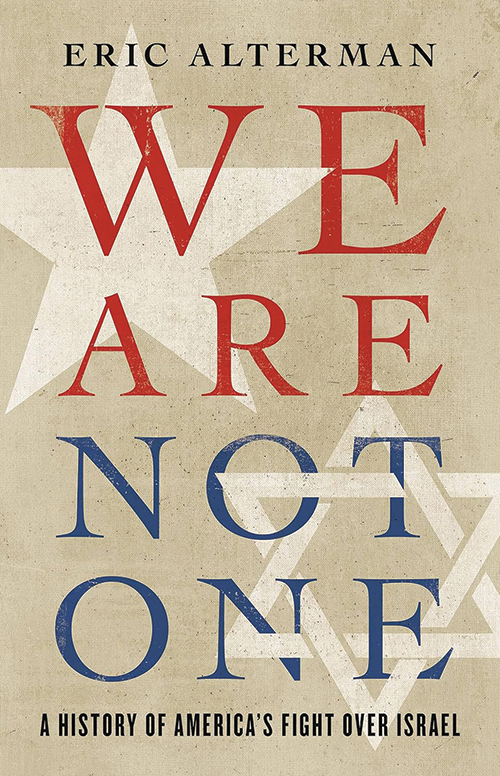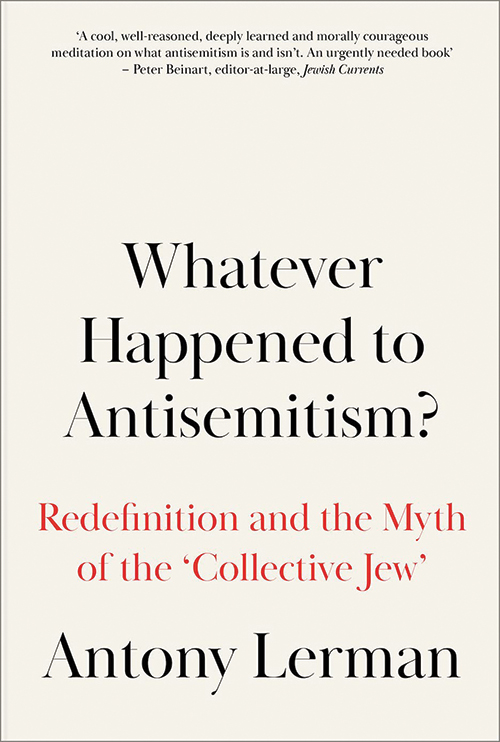
We Are Not One: A History of America’s Fight Over Israel AND Whatever Happened to Antisemitism?: Redefinition and the Myth of the “Collective Jew”
Reviewed by Steve Chase
November 1, 2023
By Eric Alterman. Basic Books, 2022. 512 pages. $35/hardcover; $19.99/eBook.

By Antony Lerman. Pluto Press, 2022. 336 pages. $23.95/paperback; $14.95/eBook.
Two of the most challenging books I have read recently are Eric Alterman’s history of the ongoing U.S. debates over Israel–Palestine and Antony Lerman’s account of the coordinated international campaign to redefine antisemitism to equate criticism of Israel’s human rights record with the hatred and oppression of Jews. Both books are thoughtful, detailed, and well-documented analyses by Jewish researchers who, like many Friends, seek to foster democracy, equality, and justice for all in Israel–Palestine and around the world.
At the beginning of We Are Not One, Eric Alterman highlights the early debates among the world’s Jewish community over the wisdom and justice of the ideology of political Zionism: a settler-colonial movement that emerged in Europe in the 1880s as one of several Jewish liberation strategies to address the harsh realities of Christian antisemitism and the persecution of Jews in Europe and elsewhere. At the time, most Jews around the world, including U.S. Jews, felt antisemitism was real and dangerous but thought that the idea of diaspora Jews colonizing Palestine, displacing the Palestinians, and creating an internationally recognized, ethnonationalist Jewish state was a far-fetched and undesirable strategy, and—to many Jews—an unjust or blasphemous one. In these early days, notes Alterman, the Zionist vision was only seriously supported in the United States by a sector of fundamentalist Christians who cared little about fighting antisemitism but fervently believed in a new religious doctrine that claimed that the Second Coming of Christ could only happen if Jews moved en masse to Palestine and recreated a Jewish state there.
How then did the political Zionist dream not only come to pass in 1948 but become supported by the United States government and much of its population? Alterman argues that this dramatic change was the result of a convergence of several historical forces. The first, of course, is the rise of the Nazis; their persecution of German Jews; and their takeover of much of Europe, which turned into an appalling European-wide mass genocide. The second was the strength of antisemitic and anti-immigrant sentiment within the United States and the anti-Nazi European powers that made their leaders politically unwilling to offer a safe haven to millions of Jewish refugees in their own countries. The third factor was that the United States and the anti-Nazi European countries were tempted by their power capacity to force the relatively powerless Palestinian Arabs to absorb hundreds of thousands of Jewish refugees who they themselves were unwilling to accept or make citizens in their own countries. The fourth factor was the intensive lobbying and public relations campaigns by now emboldened Zionists.
The result, according to Alterman, may have seemed like the path of least resistance and a politically expedient way forward at the time, but it was not a particularly stable or morally coherent solution. It is, in fact, riddled with serious contradictions. Alterman describes many different controversies and debates that arise from these contradictions. Yet one of the most important he identifies is the fact that a growing number of U.S. citizens, including many U.S. Jews, are once again coming to the conclusion that there must be a better way to fight antisemitism than settler colonialism, ethnic cleansing, military occupation, home demolitions, illegal settlements, imprisoning children without charges, or the creation of what many in the international human rights community have come to consider an apartheid regime that displaces or oppresses the Palestinian people from the Jordan River to the Mediterranean Sea.
This growing shift in public opinion has evoked considerable panic among many supporters of political Zionism, and it has pushed them to develop new strategies to reverse this troubling cultural trend. According to Antony Lerman, a British researcher who has focused his career on defining and studying antisemitism in a rigorous and coherent manner, the main strategy is the growing effort to downplay classical antisemitism and redefine the human rights concerns and moral criticisms of Israel’s anti-Palestinian policies as the “new antisemitism” that must be combatted.
I was frankly astonished at how much detail and evidence Lerman offers in his Whatever Happened to Antisemitism? to document this remarkable definitional shift in conference after conference, publication after publication, and organization after organization, and how the Israeli government has worked hard to foster this definitional shift as a way to defend itself from international human rights criticism. One specific tactic that Lerman warns people against is the well-organized campaign to lobby governments, churches, corporations, and educational and civic institutions to adopt the controversial International Holocaust Remembrance Alliance (IHRA) “working definition” of antisemitism. Why? Because the majority of the IHRA’s examples conflate advocacy for Palestinian human rights and criticisms of Israel’s anti-Palestinian policies with antisemitism and the hatred and oppression of Jews.
This, Lerman argues, muddies the human rights debate, facilitates the criminalization of free speech and constitutionally protected nonviolent protest, does little to stop extremism and violent rightwing anti-Jewish acts in the United States and Europe, and chills the advocacy of many people in these countries who have genuine moral doubts about Israeli policies but do not speak up for fear of being labeled or publicly attacked as antisemitic. All of this, Lerman maintains, weakens and undermines many efforts to foster a more just, democratic, and peaceful future in Israel–Palestine.
While resistance to political Zionism is being increasingly framed as antisemitism, it is more accurate, as explained by Lerman, to see this resistance as an objection to settler colonialism. This, at least, was the view of early Zionist leaders. Alterman tells of a conversation between Israel’s first prime minister, David Ben-Gurion, and Zionist leader Nahum Goldmann about Palestinian resistance. Ben-Gurion said to Goldman:
We come from Israel, it’s true, but two thousand years ago, and what is that to them? There has been anti-Semitism [sic], the Nazis, Hitler, Auschwitz, but was that their fault? They only see one thing: We have come here and stolen their country. Why should they accept that?
An important distinction needs to be made here, of course. The essential problem with political Zionism was not its support for increasing immigration of Jewish refugees to Palestine in the 1930s and 1940s. The problem was the creation of a government rooted in Jewish domination and Palestinian oppression. The words of Ben-Gurion echo in my ears: “Why should they accept that?” My question now is, why should we?
After reading these two important books, I am even more appreciative that this past March two Quaker organizations—American Friends Service Committee and Friends Committee on National Legislation—joined eight other U.S. Christian organizations and denominations in sending a strongly worded letter to President Joe Biden and members of Congress urging them to end the $3.8 billion military aid package that the United States gives the state of Israel every year. While a longtime concern for these two organizations, the timing of this letter was triggered by the installation of the most extremist, far-right ruling coalition in Israel’s 75-year history. The open letter notes:
The new Israeli government came to power on a platform of supremacy, stating that only Israeli Jews have a right to sovereignty in the land located between the Jordan River and the Mediterranean Sea. Netanyahu and his ministers have promised to expand existing settlements, “legalize” outposts built on Palestinian land, and establish new settlements, all while moving to formally annex the West Bank to Israel.
After reading Lerman’s book, it comes as no surprise that Gerald Steinberg, a prominent proponent of political Zionism, would proclaim, “Among church groups whose theological anti-Semitism [sic] has been transferred to opposing the State of Israel, the Quakers are a leading example.” The question is whether such claims should stop us from advocating for human rights and equality for all.
Steve Chase is a member of Friends Meeting of Washington (D.C.) and the Quaker Palestine Israel Network. He is also the author of the Pendle Hill pamphlet Boycott, Divestment, and Sanctions? A Quaker Zionist Rethinks Palestinian Rights.
2 thoughts on “We Are Not One: A History of America’s Fight Over Israel AND Whatever Happened to Antisemitism?: Redefinition and the Myth of the “Collective Jew””
Leave a Reply
Comments on Friendsjournal.org may be used in the Forum of the print magazine and may be edited for length and clarity.



I have wondered how Jewish people (I am Jewish) are not appalled and horrified at the suffering Israel is visiting on the people of Gaza. How can Jews not have empathy for people who are driven from their homes, subjected to bombings, with limited access to food and water and medicine. This is how Israel plans to kill Hamas dead: never to rise. And all the other Palestinians? They are getting a lesson in revenge.
I am not Jewish, but I can’t help but respond, Why are not Palestinians, Muslims and their supporters not appalled and horrified at what the Palestine visited upon the people of Israel on October 7? Israel did not initiate the terrorist attack. There is no symmetry between the two groups.
Interesting how people can ignore human rights abuses in one group but not the other. I understand it is illegal to be gay in Gaza. And I would shudder at the thought of being a woman there. What kind of society–other than those currently populating our “elite” educational institutions–sees the vilest form of terrorism as a legitimate means of combating an enemy?